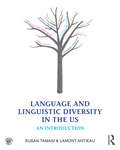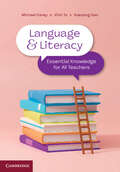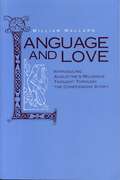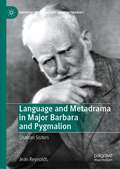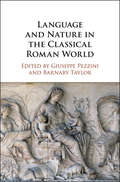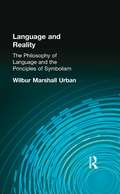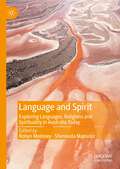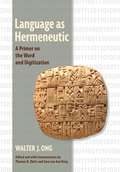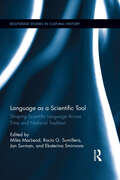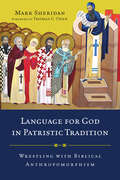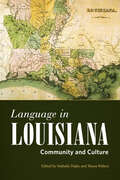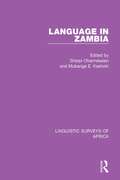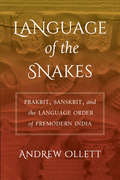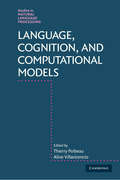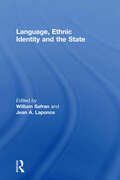- Table View
- List View
Language and History: Integrationist Perspectives (Routledge Advances in Communication and Linguistic Theory #Vol. 4)
by Nigel LoveWhen linguistics was first established as an academic discipline in the nineteenth century, it was envisaged as an essentially historical study. Languages were to be treated as historical objects, evolving through gradual but constant processes of change over long periods of time. In recent years, however, there has been much discussion by historians of a 'linguistic turn' in their own discipline, and, in linguistics, integrationist theory has mounted a radical challenge to the traditional notion of 'languages' as possible objects of inquiry.Language and History develops the integrationist critique of orthodox linguistics, while at the same time extending its implications to the field of history. By doing so, it throws light on what is now recognized by many historians to be a 'crisis' in their own discipline. Underlying the post-modernist scepticism about traditional forms of historiography, the integrationist approach reveals a more deep-seated problem concerning the interface between philosophy of history and philosophy of language. With chapters from a range of leading international contributors, Language and History represents a significant contribution to the developing work of the integrationists.
Language and Learning in Renaissance Italy: Selected Articles (Variorum Collected Studies)
by John MonfasaniLanguage was the Italian humanists’ stock-in-trade, rhetoric their core discipline. In this volume Professor Monfasani collects together his most important articles on these subjects. One group of these, including two review essays, focuses specifically on the humanist Lorenzo Valla and on his philosophy of language. The third section of the book opens out the coverage of Italian Renaissance cultural history and includes studies of several new texts - among them a description of the decoration of the Sistine Chapel, and a call for press censorship - and of the religious culture of mid-15th-century Rome. Le langage était l’instrumet de base des humanistes italiens, la rhétorique leur discipline de fond. Dans ce volume, le professeur Monfasani rassemble ses articles les plus importants sur le sujet . Un groupe d’entre eux, comprenant deux comptesrendus, se concentre spécifiquement sur l’humaniste Lorenzo Valla et sur sa philosophie du langage. La troisième section du recueil élargit le champ de connaissance de l’histoire culturelle de la Renaissance italienne et inclus des études de plusieurs textes nouveaus - parmi ceux-ci, une description de la décoration intérieure de la chapelle Sixtine et un appel à la censure de la presse -, ainsi que de la culture religieuse romaine au milieu du 15e siècle.
Language and Linguistic Diversity in the US: An Introduction
by Lamont Antieau Susan TamasiThis highly engaging textbook presents a linguistic view of the history, society, and culture of the United States. It discusses the many languages and forms of language that have been used in the US - including standard and nonstandard forms of English, creoles, Native American languages, and immigrant languages from across the globe - and shows how this distribution and diversity of languages has helped shape and define America as well as an American identity. The volume introduces the basic concepts of sociolinguistics and the politics of language through cohesive, up-to-date and accessible coverage of such key topics as dialectal development and the role of English as the majority language, controversies concerning language use in society, languages other than English used in the US, and the policies that have directly or indirectly influenced language use. These topics are presented in such a way that students can examine the inherent diversity of the communicative systems used in the United States as both a form of cultural enrichment and as the basis for socio-political conflict. The author team outlines the different viewpoints on contemporary issues surrounding language in the US and contextualizes these issues within linguistic facts, to help students think critically and formulate logical discussions. To provide opportunities for further examination and debate, chapters are organized around key misconceptions or questions ("I don't have an accent" or "Immigrants don't want to learn English"), bringing them to the forefront for readers to address directly. Language and Linguistic Diversity in the US is a fresh and unique take on a widely taught topic. It is ideal for students from a variety of disciplines or with no prior knowledge of the field, and a useful text for introductory courses on language in the US, American English, language variation, language ideology, and sociolinguistics.
Language and Literacy: Essential Knowledge for All Teachers
by Xuesong Gao Michael Carey Vinh ToLiteracy is important foundational knowledge for all teaching areas and classroom settings. Language and Literacy covers the building blocks of literacy, as well as the developmental skills all pre-service and in-service teachers need to teach effectively and meaningfully across the Australian curriculum. Part one moves chronologically from the early years to the secondary years, covering phonological, phonemic and morphological awareness, word and sentence-level grammar, language use in social contexts, and a discussion on English language diversity and change. Part two introduces the metalanguage, content knowledge and teaching methods required to develop students' competence in vocabulary, text types and grammar, as well as oracy, reading, writing and critical literacy. Each chapter includes discussion points and further resources to engage students, with key terms linked to the comprehensive glossary. Written by experienced educators, Language and Literacy is an essential resource, offering a focused exploration of language and literacy knowledge for pre-service and in-service teachers.
Language and Love: Introducing Augustine's Religious Thought Through the Confessions Story (G - Reference, Information and Interdisciplinary Subjects)
by William MallardThis is the first work to combine an introduction to Augustine's Confessions with a larger outline of his mature theology. Mallard provides guidance for reading the narrative Confessions (Books I–IX) and at the same time, by certain extensions and comments, reveals the three major topical divisions within Augustine's thought: creation, salvation, and the City of God. Mallard is able to do this because Augustine's affirmation of the good of Creation, his view of the human will and God's grace (and the nature of evil), his sense of a religious people's identity and their hope, and his view of faith and reason were all essentially in place at the time of the Confessions.Mallard argues that Augustine was not "in search of himself" in a modern sense but in search of a language of prayer, praise, and truth that would locate him within God's grace. That language turned out to be the language of Incarnation, which remains compelling and inviting today. As a classic work, the Confessions is a monument to its own time, but it has striking resonances for our own. Mallard's interpretation will challenge readers to begin working out their own. The Confessions endures because it is a story that illumines the stories of many, even to the present day. To analyze how it is like, and unlike, modern experiences is to exercise both mind and heart. In that respect, Language and Love is a kind of theological meditation on the Confessions testing out a horizon of belief. Mallard views Augustine as a master of the spoken word in an age of broken and abused language and the Confessions as a historic masterpiece of rhetoric. He contends that Augustine is the ancestor of many today who offer social and political hope through fresh rhetorical vitality.
Language and Metadrama in Major Barbara and Pygmalion: Shavian Sisters (Bernard Shaw and His Contemporaries)
by Jean ReynoldsThis book focuses on two important topics in Shaw’s Major Barbara and Pygmalion that have received little attention from critics: language and metadrama. If we look beyond the social, political, and economic issues that Shaw explored in these two plays, we discover that the stories of the two “Shavian sisters”— Barbara Undershaft and Eliza Doolittle—are deeply concerned with performance and what Jacques Derrida calls “the problem of language.” Nearly every character in Major Barbara produces, directs, or acts in at least one miniature play. In Pygmalion, Henry Higgins is Eliza’s acting coach and phonetics teacher, as well as the star of an impromptu, open-air phonetics show. The language content in these two plays is just as intriguing. Did Eliza Doolittle have to learn Standard English to become a complete human being? Should we worry about the bad grammar we hear at Barbara Undershaft’s Salvation Army shelter? Is English losing its precision and purity? Meanwhile, in the background, Shaw keeps reminding us that language and theatre are always present in our everyday lives—sometimes serving as stabilizing forces, and sometimes working to undo them.
Language and Nature in the Classical Roman World
by Giuseppe Pezzini Barnaby TaylorA familiar theme in Greek philosophy, largely due to the influence of Plato's Cratylus, linguistic naturalism (the notion that linguistic facts, structures or behaviour are in some significant sense determined by nature) constitutes a major but under-studied area of Roman linguistic thought. Indeed, it holds significance not only for the history of linguistics but also for philosophy, stylistics, rhetoric and more. The chapters in this volume deal with a range of naturalist theories in a variety of authors including Cicero, Varro, Nigidius Figulus, Posidonius, and Dionysius of Halicarnassus. The result is a complex and multi-faceted picture of how language and nature were believed to interrelate in the classical Roman world.
Language and Reality: The Philosophy of Language and the Principles of Symbolism
by Wilbur Marshall UrbanFirst published in 2002. Routledge is an imprint of Taylor & Francis, an informa company.
Language and Revolution: Making Modern Political Identities (Cummings Center Series #Vol. 16)
by Igal HalfinThis work examines the role of language in forging the modern subject. Focusing on the idea of the "New Man" that has animated all revolutionaries, the present volume asks what it meant to define oneself in terms of one's class origins, gender, national belonging or racial origins.
Language and Spirit: Exploring Languages, Religions and Spirituality in Australia Today
by Robyn Moloney Shenouda MansourThis edited book explores stories of linguistic and spiritual identity in the urban and rural Australian landscape. It is an innovative mix of thirty six personal narratives and eleven research studies, which together offer accounts of the intersection of languages, religion and spirituality in people’s lives. Teachers of Indigenous languages speak of the critical connection between language revitalization, the spirituality of Country, and well-being. Both new and long-established diaspora individuals speak of the often complex but vital joint role of language and faith in belonging and heritage. The new dimension which the book brings to multilingualism is relevant to all complex global societies. Language and Spirit is ideal for both the general reader interested in community languages and interfaith issues, and academics in global intercultural studies and Applied Linguistics study wishing to gain a nuanced insight into the Language and Spirit intersection.
Language and linguistic contact in ancient Sicily
by Olga Tribulato"Within the field of ancient bilingualism, Sicily represents a unique terrain for analysis as a result of its incredibly rich linguistic history, in which 'colonial' languages belonging to branches as diverse as Italic (Oscan and Latin), Greek and Semitic (Phoenician) interacted with the languages of the natives (the elusive Sicel, Sicanian and Elymian). The result of this ancient melting-pot was a culture characterised by 'postcolonial' features such as ethnic hybridity, multilingualism and artistic and literary experimentation. While Greek soon emerged as the leading language, dominating official communication and literature, epigraphic sources and indirect evidence show that the minority languages held their ground down to the fifth century BCE, and in some cases beyond. The first two parts of the volume discuss these languages and their interaction with Greek, while the third part focuses on the sociolinguistic revolution brought about by the arrival of the Romans"--
Language as Hermeneutic: A Primer on the Word and Digitization
by Walter J. OngLanguage in all its modes—oral, written, print, electronic—claims the central role in Walter J. Ong’s acclaimed speculations on human culture. After his death, his archives were found to contain unpublished drafts of a final book manuscript that Ong envisioned as a distillation of his life’s work. This first publication of Language as Hermeneutic, reconstructed from Ong’s various drafts by Thomas D. Zlatic and Sara van den Berg, is more than a summation of his thinking. It develops new arguments around issues of cognition, interpretation, and language. Digitization, he writes, is inherent in all forms of "writing," from its early beginnings in clay tablets. As digitization increases in print and now electronic culture, there is a corresponding need to counter the fractioning of digitization with the unitive attempts of hermeneutics, particularly hermeneutics that are modeled on oral rather than written paradigms.In addition to the edited text of Language as Hermeneutic, this volume includes essays on the reconstruction of Ong’s work and its significance within Ong’s intellectual project, as well as a previously unpublished article by Ong, "Time, Digitization, and Dalí's Memory," which further explores language’s role in preserving and enhancing our humanity in the digital age.
Language as a Scientific Tool: Shaping Scientific Language Across Time and National Traditions (Routledge Studies in Cultural History)
by Miles MacLeod, Rocío G. Sumillera, Jan Surman and Ekaterina SmirnovaLanguage is the most essential medium of scientific activity. Many historians, sociologists and science studies scholars have investigated scientific language for this reason, but only few have examined those cases where language itself has become an object of scientific discussion. Over the centuries scientists have sought to control, refine and engineer language for various epistemological, communicative and nationalistic purposes. This book seeks to explore cases in the history of science in which questions or concerns with language have bubbled to the surface in scientific discourse. This opens a window into the particular ways in which scientists have conceived of and construed language as the central medium of their activity across different cultural contexts and places, and the clashes and tensions that have manifested their many attempts to engineer it to both preserve and enrich its function. The subject of language draws out many topics that have mostly been neglected in the history of science, such as the connection between the emergence of national languages and the development of science within national settings, and allows us to connect together historical episodes from many understudied cultural and linguistic venues such as Eastern European and medieval Hebrew science.
Language for God in Patristic Tradition: Wrestling with Biblical Anthropomorphism
by Mark SheridanLanguage for God in Patristic Tradition
Language in Louisiana: Community and Culture (America's Third Coast Series)
by Nathalie Dajko and Shana WaltonContributions by Lisa Abney, Patricia Anderson, Albert Camp, Katie Carmichael, Christina Schoux Casey, Nathalie Dajko, Jeffery U. Darensbourg, Dorian Dorado, Connie Eble, Daniel W. Hieber, David Kaufman, Geoffrey Kimball, Thomas A. Klingler, Bertney Langley, Linda Langley, Shane Lief, Tamara Lindner, Judith M. Maxwell, Rafael Orozco, Allison Truitt, Shana Walton, and Robin WhiteLouisiana is often presented as a bastion of French culture and language in an otherwise English environment. The continued presence of French in south Louisiana and the struggle against the language's demise have given the state an aura of exoticism and at the same time have strained serious focus on that language. Historically, however, the state has always boasted a multicultural, polyglot population. From the scores of indigenous languages used at the time of European contact to the importation of African and European languages during the colonial period to the modern invasion of English and the arrival of new immigrant populations, Louisiana has had and continues to enjoy a rich linguistic palate. Language in Louisiana: Community and Culture brings together for the first time work by scholars and community activists, all experts on the cutting edge of research. In sixteen chapters, the authors present the state of languages and of linguistic research on topics such as indigenous language documentation and revival; variation in, attitudes toward, and educational opportunities in Louisiana’s French varieties; current research on rural and urban dialects of English, both in south Louisiana and in the long-neglected northern parishes; and the struggles more recent immigrants face to use their heritage languages and deal with language-based regulations in public venues. This volume will be of value to both scholars and general readers interested in a comprehensive view of Louisiana’s linguistic landscape.
Language in Zambia (Linguistic Surveys of Africa #6)
by Sirarpi Ohannessian Mubanga E. KashokiOriginally published in 1978, this volume is divided into 3 parts. Part 1 presents an overview of the linguistic situation in Zambia: who speaks which languages, where they are spoken, what these languages are like. Special emphasis is given to the extensive survey of the languages of the Kafue basin, where extensive changes and relocations have taken place. Part 2 is on language use: patterns of competence and of extension for certain languages in urban settings, configurations of comprehension across language boundaries, how selected groups of multilinguals employ each of their languages and for what purposes, what languages are used in radio and television broadcasting and how decisions to use or not use a language are made. Part 3 involves language and formal education: what languages, Zambian and foreign, are used at various levels int he schools, which are taught, with what curricula, methods, how teachers are trained, how issues such as adult literacy are approached and with what success.
Language of Vision
by Gyorgy KepesLANGUAGE OF VISION is a timely, courageous book without parallel in its field. It deals with present-day problems of visual expression from a realistic and human point of view, and endeavors to escape from the narrow confines of the laboratory, preserving the closest possible contact with our experiences of every day life. It makes an extensive analysis of the structure and function of the graphic image in painting, photography and advertising design. It inquires deeply into the laws of visual organization and evaluates in contemporary terms the various representation devices conceived by artists of all ages such as—size, vertical location, overlapping, transparency, perspective, interpenetration, light and color, movement, etc., etc.318 illustrations supplement the text. There is a great variety of subject matter, techniques and media. They include photograms, photomontages and collages; analytical diagrams, typography, calligraphy and lettering; pre-historic art, paintings and drawings by children; significant work of the old masters and contemporary artists including Arp, Braque, Duchamp, Degas, Juan Gris, Helion, Klee, Kandinsky, Leger, Malevich, Matisse, Moholy-Nagy, Miro, Mondrian, Picasso, Seurat and many others. Advertising design by Bayer, Binder, Beall, Burtin, Cassandre, Carlu, Doesburg, Lissitzky, Man Ray, McKnight Kauffer, Sutnar, Tschichold, etc., etc.LANGUAGE OF VISION with its completely new concept of appraisal and revaluation is a book of vital importance to every one who feels the urgent need for a clearer understanding of the structure and function of art in our society.
Language of the Revolution: The Discourse of Anti-Communist Movements in the “Eastern Bloc” Countries: Case Studies (Palgrave Studies in Languages at War)
by Eugen Wohl Elena PăcurarThis edited book fills a void in the existing research concerning anti-communist movements in Central and Eastern Europe, outlining the linguistic implications of the cultural, social and political metamorphoses brought about by the (change of) regime. The authors included in this volume approach the topic from a variety of perspectives, but, ultimately, focus on language seen as a fundamental tool for simultaneously subjugating and liberating, concealing and revealing truth, discouraging dissidence and fostering revolt. Readers are invited to discover the linguistic implications of the many shapes and forms that the 1989 anti-communist revolutions took. Equally interesting are the investigations of the revolution aftermath, in the first years of transition to democracy. Perceived as a whole throughout the Cold War (1947-1991), the so-called "Eastern Bloc" managed to reveal its heterogeneity, the singularity of each of its comprising states and the multitude of its internal contrasts, most vividly perhaps, in the manifold manifestations of the 1989 anti-communist fight. This book will be of interest to academics and researchers from various fields, including history, (socio)linguistics, political studies, and conflict studies.
Language of the Snakes: Prakrit, Sanskrit, and the Language Order of Premodern India
by Andrew OllettAt publication date, a free ebook version of this title will be available through Luminos, University of California Press’s Open Access publishing program. Visit www.luminosoa.org to learn more.Language of the Snakes traces the history of the Prakrit language as a literary phenomenon, starting from its cultivation in courts of the Deccan in the first centuries of the common era. Although little studied today, Prakrit was an important vector of the kavya movement and once joined Sanskrit at the apex of classical Indian literary culture. The opposition between Prakrit and Sanskrit was at the center of an enduring “language order” in India, a set of ways of thinking about, naming, classifying, representing, and ultimately using languages. As a language of classical literature that nevertheless retained its associations with more demotic language practices, Prakrit both embodies major cultural tensions—between high and low, transregional and regional, cosmopolitan and vernacular—and provides a unique perspective onto the history of literature and culture in South Asia.
Language of the Spirit: An Introduction to Classical Music
by Jan SwaffordFor many of us, classical music is something serious-something we study in school, something played by cultivated musicians at fancy gatherings. In Language of the Spirit, renowned music scholar Jan Swafford argues that we have it all wrong: classical music has something for everyone and is accessible to all. Ranging from Gregorian chant to Handel's Messiah, from Vivaldi's The Four Seasons to the postmodern work of Philip Glass, Swafford is an affable and expert guide to the genre. He traces the history of Western music, introduces readers to the most important composers and compositions, and explains the underlying structure and logic of their music.Language of the Spirit is essential reading for anyone who has ever wished to know more about this sublime art.
Language, Cognition, and Computational Models (Studies in Natural Language Processing)
by Aline Villavicencio Thierry PoibeauHow do infants learn a language? Why and how do languages evolve? How do we understand a sentence? This book explores these questions using recent computational models that shed new light on issues related to language and cognition. The chapters in this collection propose original analyses of specific problems and develop computational models that have been tested and evaluated on real data. Featuring contributions from a diverse group of experts, this interdisciplinary book bridges the gap between natural language processing and cognitive sciences. It is divided into three sections, focusing respectively on models of neural and cognitive processing, data driven methods, and social issues in language evolution. This book will be useful to any researcher and advanced student interested in the analysis of the links between the brain and the language faculty.
Language, Democracy, and the Paradox of Constituent Power: Declarations of Independence in Comparative Perspective
by Catherine FrostIn this book, Catherine Frost uses evidence and case studies to offer a re-examination of declarations of independence and the language that comprises such documents. Considered as a quintessential form of founding speech in the modern era, declarations of independence are however poorly understood as a form of expression, and no one can completely account for how they work. Beginning with the founding speech in the American Declaration, Frost uses insights drawn from unexpected or unlikely forms of founding in cases like Ireland and Canada to reconsider the role of time and loss in how such speech is framed. She brings the discussion up to date by looking at recent debates in Scotland, where an undeclared declaration of independence overshadows contemporary politics. Drawing on the work of Hannah Arendt and using a contextualist, comparative theory method, Frost demonstrates that the capacity for renewal through speech arises in aspects of language that operate beyond conventional performativity. Language, Democracy, and the Paradox of Constituent Power is an excellent resource for researchers and students of political theory, democratic theory, law, constitutionalism, and political history.
Language, Ethnic Identity and the State
by William Safran and Jean A. LaponceThis new study powerfully asserts the pivotal importance of the interplay between language and ethnicity, which is often underestimated as a component for political stability. These leading scholars present five key case studies of South Africa, Algeria, Canada, Latvia and Senegal. All five countries are multilingual nations where language has been a central political issue that has challenged their unity and stability.These studies are underpinned by two general, comparative and theoretical discussions, which analyse how scholars consider social class and economic factors to be the primary sources for political cohesion or of malcontent with the system and the new avenues opened by a focus on issues of langauge. This book will be of great interest to all students and scholars of linguistics, language, politics and sociology. This is a special issue of the leading journal Nationalism and Ethnic Politics.
Language, Gender and Politics in Central and Eastern Europe (Palgrave Studies in Language, Gender and Sexuality)
by Ksenija BogetićThis volume is the first book-length collection of research on language, gender and sexuality in the societies of central and eastern Europe. Spanning a range of languages and political contexts, the chapters shed light on the intense debates that connect language use, gender equality, sexuality, history and belonging in this region today, while advancing perspectives on semiotic resignification that complicate some western-dominated frameworks in the discipline. Focused on a space increasingly described as a hub of ‘anti-gender’ hostility – as we currently witness in the curtailing of abortion rights, removal of gender from curricula and institutionalisation of anti-LBGTQ rhetoric – the book also foregrounds the rich continuities of feminist theory and protest in post-socialist societies, and their import for rethinking transnational sociolinguistic perspectives on heteronormative patriarchy, ‘anti-genderism’, neoliberalism, imperialism and conflict. Showcasing a range of approaches, themes and angles of inquiry, the book will be of interest to scholars and postgraduate students researching the topics of gender and sexuality within linguistics, but also within other interdisciplinary areas of the humanities and social sciences.
Language, Gender, and Citizenship in American Literature, 1789-1919 (Studies in American Popular History and Culture)
by Amy Dunham StrandExamining language debates and literary texts from Noah Webster to H.L. Mencken and from Washington Irving to Charlotte Perkins Gilman, this book demonstrates how gender arose in passionate discussions about language to address concerns about national identity and national citizenship elicited by 19th-century sociopolitical transformations. Together with popular commentary about language in Congressional records, periodicals, grammar books, etiquette manuals, and educational materials, literary products tell stories about how gendered discussions of language worked to deflect nationally divisive debates over Indian Removal and slavery, to stabilize mid-19th-century sociopolitical mobility, to illuminate the logic of Jim Crow, and to temper the rise of "New Women" and "New Immigrants" at the end and turn of the 19th century. Strand enhances our understandings of how ideologies of language, gender, and nation have been interarticulated in American history and culture and how American literature has been entwined in their construction, reflection, and dissemination.


